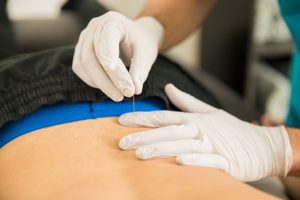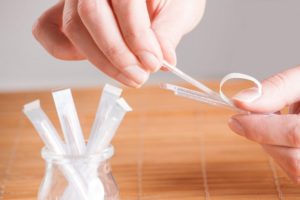Dry Needling is a treatment technique in which a sterile, single-use, fine filament needle (acupuncture needle) is inserted into the muscle to assist in-reducing pain and improving function by releasing myofascial trigger points, commonly referred to as knots

Is Dry Needling same as Acupuncture?
Dry Needling releases myofascial trigger points in muscle there by decreasing of pain and restoring function. Whereas, acupuncture focuses on the treatment of medical conditions by restoring the flow of energy (Qi) through key points in the body (meridians) to restore balance. The main similarity is the type of needle used for both techniques.
Myofascial Trigger Point
A myofascial trigger point is like a knot in the muscle fibres which can be painful when palpated. A group of muscle fibres within the muscle have been shortened due to activation and are unable to return to its original length. This becomes a painful nodule as the muscle fibres become so tight that it causes compression on the capillaries and nerves around it. This becomes a viscous cycle as it further hinders the normal movement of the muscle causing stagnation in the circulation and accumulation of waste products which in turn causes pain. The remainder of the muscle tightens in response and cause pain or discomfort to touch, movement, stretching leading to reduction in joint movement and/or temporary loss of coordination.
Causes of Myofascial Trigger Point
A myofascial trigger point develops as part of the body’s protective response following:
- Injury –to reduce the extent of injury the muscle Guards by tightening
- Unanticipated movements e.g. descending a step that is lower than originally anticipated;
- Sudden movements e.g. Checking blind spot while driving
- Change in regular activity g. an increase in the activity like sport or gym work
- Prolonged postures e.g. prolonged sitting
- Nerve impingement – the muscle will tighten to protect the nerve;
- Stress
How does Dry Needling Work?
Dry needling works by restoring the ability of the muscle to contract and relax normally by releasing the myofascial trigger point. This will help in reducing local muscular pain.
When a fine filament needle is inserted into the center of a myofascial trigger point it improving blood circulation around the needle triggering the contracted muscle fibers to relax. This brings fresh oxygen and nutrients and washes any additional acidic chemicals. This, in turn, leads to the decompression of the local blood and nerve supply.
Dry Needling can be used in treatment:
- to help release myofascial trigger points (muscle knots);
- to assist with pain management, and;
- to restore movement at a joint if inhibited by myofascial trigger points.
Dry Needling Treatment experience
During a Dry Needling treatment, you may feel a slight sting as the needle is inserted and removed. However, this discomfort should last no longer than a second before settling. A short muscle twitch can also be experienced. This may occur when the needle is inserted into a myofascial trigger point.
Dry Needling in Rehabilitation
Dry Needling is one of many techniques that can be utilised by your physiotherapist to assist in pain reduction in your rehab. Dry Needling is often used as an adjunct to massage, manual therapy, and exercise prescription.
Side Effects of Dry Needling
Your physiotherapist will determine whether Dry Needling is suitable for you based on your injury and your general health. There are some risks associated with it and your Physiotherapist will explain to you before taking your consent. There could be spotting or bruising, fainting, nausea, residual discomfort or even altered energy levels. However, these symptoms should last no longer than 24 to 48 hours after treatment.
When Dry Needling is performed, single-use, sterile needles are always used and disposed of immediately after use into a certified sharps container.
Exercise After Dry Needling
It is recommended to avoid strenuous or high impact activities immediately after Dry Needling, to allow the body time to recover, and to maximise the benefits of the treatment.